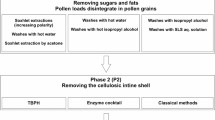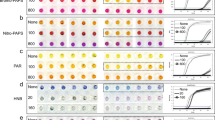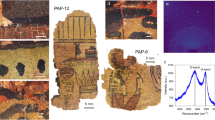Abstract
IN recent years fluorescence microscopy has proved useful in bacterial identification and other clinical diagnostic procedures including the fluorescent antibody technique. Various fluorochromes have also been used in identifying soil bacteria1 or distinguishing them from soil humus2. Richards and Miller3 and Richards et al.4 reported that staining the tubercle organism with auramine O markedly enhanced its visualization, made possible the observation of large fields at low magnification, and thus increased the possibility of obtaining positive diagnoses. Some of these uses and others have been reviewed by Perner5. During examination of foliar penetration and movement of fluorescent dyes by fluorescence microscopy6–12 we observed that pollen grains entangled in the trichomes of Prosopis juliflora (mesquite) fluoresced brilliantly. The use of acridine orange in enhancing morphological detail of fresh pollen grains was afterwards described by Ratcliffe et al.13. The question at once arose as to whether fossil pollen in soil and sediment samples would respond in the same fashion.
This is a preview of subscription content, access via your institution
Access options
Subscribe to this journal
Receive 51 print issues and online access
$199.00 per year
only $3.90 per issue
Buy this article
- Purchase on Springer Link
- Instant access to full article PDF
Prices may be subject to local taxes which are calculated during checkout
Similar content being viewed by others
References
Conn, H. J., Biological Stains, 355 (Williams and Wilkins, Baltimore, Maryland, 1961).
Strugger, S., Canad. J. Res., Sec. C, 26, 188 (1948).
Richards, O. W., and Miller, D. K., J. Clin. Pathol., 11, 1 (1941).
Richards, O. W., Kline, E. K., and Leach, R. E., American Rev. Tuberc., 44, 255 (1941).
Perner, E. S., in Handbuch der Mikroskcopie in der Technik, edit. by Freund, H., 357 (Umschau Verlag, Frankfurt-am-Main, 1957).
Bauer, L., Planta, 42, 367 (1953).
Butterfass, Th., Protoplasma, 47, 415 (1956).
Dybing, C. D., and Currier, H. B., Plant Physiol., 36, 169 (1961).
Schlafke, E., Planta, 50, 388 (1958).
Schumacher, W., Naturwiss., 34, 176 (1947).
Steubing, L., Biol. Zentr., 68, 252 (1949).
Strugger, S., Flora (Jena), 132, 253 (1938).
Ratcliffe, H. E., Turner, T. R., and Griggs, jun., W. H., J. Allergy, 34, 116 (1963).
Martin, P. S., Ecology, 44, 436 (1963).
Martin, P. S., Schoenwetter, J., and Arms, B. C., Southwestern Palynology and Prehistory, the Last 10,000 Years (Univ. of Ariz., Geochronology Laboratories, Tucson, 1961).
Bhaduri, P. N., and Bhanja, P. K., Stain Technology, 37, 351 (1962).
Wetzel, W., Erdöl u. Kohle, 13, 541 (1960).
Author information
Authors and Affiliations
Rights and permissions
About this article
Cite this article
SHELLHORN, S., HULL, H. & MARTIN, P. Detection of Fresh and Fossil Pollen with Fluorochromes. Nature 202, 315–316 (1964). https://doi.org/10.1038/202315a0
Issue Date:
DOI: https://doi.org/10.1038/202315a0
This article is cited by
Comments
By submitting a comment you agree to abide by our Terms and Community Guidelines. If you find something abusive or that does not comply with our terms or guidelines please flag it as inappropriate.



